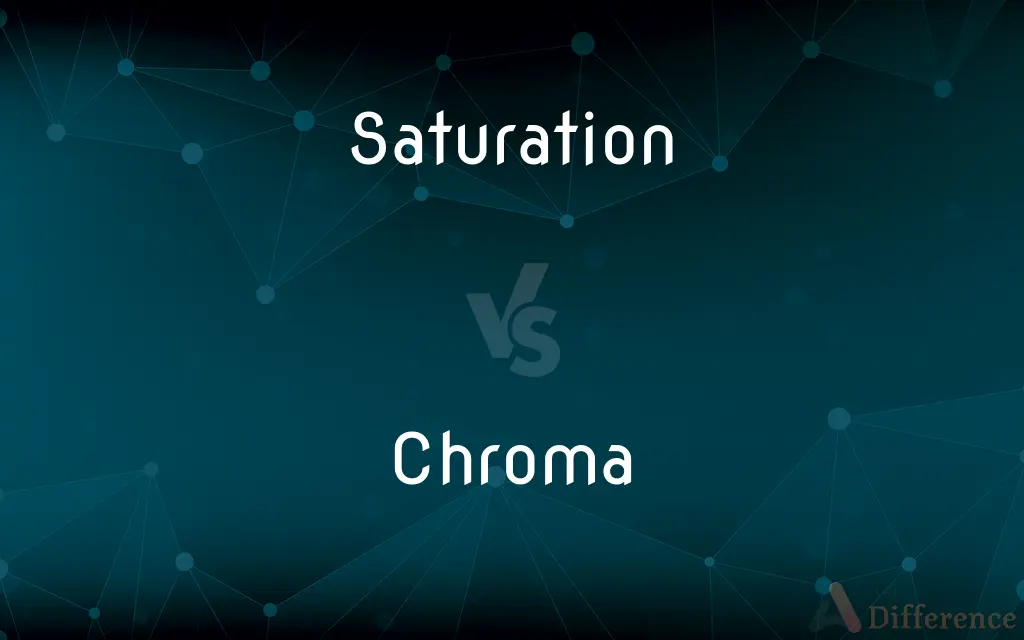Saturation vs. Chroma — What's the Difference?
By Urooj Arif & Fiza Rafique — Updated on May 7, 2024
Saturation refers to the intensity and purity of a color, while chroma measures the vividness relative to the brightness of white.

Difference Between Saturation and Chroma
Table of Contents
ADVERTISEMENT
Key Differences
Saturation describes how a color appears under certain lighting conditions, particularly how it differs from a gray of the same darkness or lightness. Whereas, chroma defines a color’s purity when compared to white, emphasizing how much it deviates from a neutral gray.
In the context of color theory, saturation is often considered in terms of a color's strength or weakness; a desaturated color looks more washed out and closer to gray. On the other hand, chroma deals with the color's brilliance as compared to the brightness of white, making it a specific aspect of the color's intensity as perceived in relation to white.
When adjusting color in photography or digital art, increasing saturation will make the colors appear more "pure" and less grayish, whereas increasing chroma enhances the distinctness from white without altering its luminance.
High saturation can make an image feel more vibrant and lively, which is beneficial for high-energy visuals. Conversely, high chroma colors stand out more distinctly in compositions where brightness and contrast with white are important, such as in design and art.
Understanding the difference between saturation and chroma is crucial for artists and designers, as these elements affect color manipulation and the emotional response to color in visual compositions.
ADVERTISEMENT
Comparison Chart
Definition
Intensity of a color vs. gray
Color’s vividness vs. white
Related to
Color purity and vividness
Color intensity and contrast to white
Key in
Overall color perception
Specific contexts like art and design
Visual Impact
Creates vibrant or muted effects
Enhances or dulls contrast with white
Used in
Photography, painting, design
Color theory, painting, design
Compare with Definitions
Saturation
The degree to which something is absorbed or dissolved.
The soil's saturation with nutrients is essential for plant growth.
Chroma
Quality of a color as determined by its purity and its dominance over brightness or lightness.
Artists often adjust chroma to bring a subtle depth to their paintings.
Saturation
The state or process that occurs when no more of something can be absorbed, combined with, or added.
The market is nearing saturation with these products.
Chroma
A measure of color's deviation from gray.
Chroma defines how much a hue differs from a neutral gray at the same lightness.
Saturation
Purity of a color, as measured by its freedom from white or gray.
Increasing the saturation in the photo made the blues and greens more vibrant.
Chroma
The intensity of distinctive hue in a color.
A high chroma color is vivid and clear, standing out in a design.
Saturation
Fullness of the sound or color in recording or broadcasting.
Adjusting the saturation changes how rich the colors appear on screen.
Chroma
The component of a television or video signal that carries color information.
The TV's color settings were adjusted to enhance chroma and improve color accuracy.
Saturation
Intensity of a magnetic or electric field.
Saturation of the magnetic field is a critical factor in transformer design.
Chroma
Saturation in terms of the digital color model.
In digital imaging, chroma adjustments can make colors pop against a white background.
Saturation
The act or process of saturating.
Chroma
The aspect of color in the Munsell color system by which a sample appears to differ from a gray of the same lightness or brightness and that corresponds to saturation of the perceived color.
Saturation
The condition of being saturated.
Chroma
The colorfulness relative to the brightness of a similarly illuminated area
Saturation
The condition of being full to or beyond satisfaction; satiety.
Chroma
The aspect of a colour's hue that depends on the amount of white or black in it; saturation
Saturation
(Physics) A state of a ferromagnetic substance in which an increase in applied magnetic field strength does not produce an increase in magnetization.
Chroma
(music) A note in a chromatic scale
Saturation
(Chemistry) The state of a compound or solution that is fully saturated.
Chroma
Chromatic purity: freedom from dilution with white and hence vividness of hue
Saturation
(Meteorology) A condition in which air at a specific temperature contains all the water vapor it can hold; 100 percent relative humidity.
Saturation
Vividness of hue; degree of difference from a gray of the same lightness or brightness. Also called intensity. See Table at color.
Saturation
Intensive shelling or bombing of a military target to achieve total destruction.
Saturation
The flooding of a market with all of a commodity that consumers can purchase.
Saturation
The act of saturating or the process of being saturated
Saturation
(physics) The condition in which, after a sufficient increase in a causal force, no further increase in the resultant effect is possible; e.g. the state of a ferromagnetic material that cannot be further magnetized
Saturation
(chemistry) The state of a saturated solution
Saturation
(chemistry) The state of an organic compound that has no double or triple bonds
Saturation
(meteorology) The state of the atmosphere when it is saturated with water vapour; 100% humidity
Saturation
(art) The intensity or vividness of a colour.
Saturation
(color) Chromatic purity; freedom from dilution with white.
Saturation
Intense bombing of a military target with the aim of destroying it
Saturation
The flooding of a market with all of a product that can be sold
Saturation
(music) An effect on the sound of an electric guitar, used primarily in heavy metal music
Saturation
(telecommunications) The condition at which a component of the system has reached its maximum traffic-handling capacity, i.e. one erlang per circuit.
Saturation
(telecommunications) The point at which the output of a linear device, such as a linear amplifier, deviates significantly from being a linear function of the input when the input signal is increased.
Modulation often requires that amplifiers operate below saturation.
Saturation
The act of saturating, or the state of being saturating; complete penetration or impregnation.
Saturation
The act, process, or result of saturating a substance, or of combining it to its fullest extent.
Saturation
Freedom from mixture or dilution with white; purity; - said of colors.
Saturation
The process of totally saturating something with a substance;
The impregnation of wood with preservative
The saturation of cotton with ether
Saturation
The act of soaking thoroughly with a liquid
Saturation
A condition in which a quantity no longer responds to some external influence
Saturation
Chromatic purity: freedom from dilution with white and hence vividness of hue
Common Curiosities
What is the primary difference between saturation and chroma?
Saturation refers to the intensity of a color compared to gray, while chroma measures color intensity in relation to white.
Can saturation and chroma affect the emotional tone of a piece?
Yes, higher saturation and chroma can make images appear more lively and energetic, affecting viewer perception and emotion.
What tools can adjust saturation and chroma in digital media?
Photo editing software like Adobe Photoshop and Lightroom allows precise control over both saturation and chroma settings.
How do saturation and chroma relate to color theory?
They are key components in understanding and applying color interactions and relationships in various artistic and design contexts.
How does changing saturation affect an image?
Increasing saturation makes the colors more vivid and less gray, enhancing the overall vibrancy of the image.
How do saturation and chroma interact in digital color models?
In digital environments, both saturation and chroma are manipulated to achieve desired visual effects, balancing color intensity and contrast.
Why is understanding chroma important for designers?
Designers use chroma to create visual hierarchies and focus in their layouts, enhancing the effectiveness of visual communication.
What role does chroma play in art?
Chroma helps artists control the vividness of colors relative to white, influencing the contrast and emphasis in artwork.
Can an increase in chroma make a color appear lighter?
No, increasing chroma enhances a color's vividness without affecting its lightness.
What happens to an image with low saturation and high chroma?
The image will have colors that are not very vivid but are distinctly different from white, possibly appearing more refined or subtle.
Share Your Discovery

Previous Comparison
Humanely vs. Humanly
Next Comparison
Founding vs. FundingAuthor Spotlight
Written by
Urooj ArifUrooj is a skilled content writer at Ask Difference, known for her exceptional ability to simplify complex topics into engaging and informative content. With a passion for research and a flair for clear, concise writing, she consistently delivers articles that resonate with our diverse audience.
Co-written by
Fiza RafiqueFiza Rafique is a skilled content writer at AskDifference.com, where she meticulously refines and enhances written pieces. Drawing from her vast editorial expertise, Fiza ensures clarity, accuracy, and precision in every article. Passionate about language, she continually seeks to elevate the quality of content for readers worldwide.













































